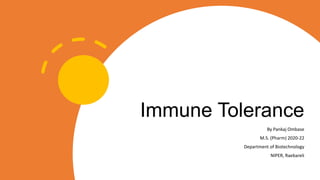
Immune tolerance
- 1. Immune Tolerance By Pankaj Ombase M.S. (Pharm) 2020-22 Department of Biotechnology NIPER, Raebareli
- 2. Antigen • Recognized by our body as foreign • Stimulate an Immune response • Can be self or non self • Two main divisions of antigens are recognized foreign antigens ( hetero antigens) and autoantigens (self antigen). • Foreign antigens originate from outside the body. Examples include parts of or substances produced by virus or microorganisms as well as substances in snake venom, certain protein in foods, and components of serum and RBC from other individuals. • Autoantigens is originate within the body. Example are cells of the body or fragments, compounds, or antigenic products of metabolism
- 3. Self antigen No immune response Immune tolerance Self antigen Immune response Auto immune disorder
- 4. What is Tolerance in Immunology • Immune tolerance or immunological tolerance or immunotolerance is a state of unresponsiveness of the immune system to substances or tissue that have the capacity to elicit an immune response in a given organism.
- 5. Definitions : Self-tolerance is the ability of the immune system to recognize self-produced antigens as a non-threat Induced tolerance occurs when the immune system actively avoids responding to an external antigen Central tolerance mechanisms occur during lymphocyte development, either in the thymus for T cells or in the bone marrow for B cells in which most of the autoreactive T cells or B cells are eliminated. Peripheral tolerance mechanisms occur after mature lymphocytes are released into the lymph nodes or other tissues. These mechanisms are useful to prevent autoreactive immune cells that have survived the mechanisms of central tolerance from damaging the periphery.
- 6. Central T cell Tolerance : • T cell origin is bone marrow and maturation take place in thymus. • Fate of developing T cell depend on the strength with which immature T cell interact with self peptide ( antigen ) : self MHC molecule No Selection No interaction Apoptosis of T cell Positive selection moderate interaction survival of T cell Negative selection strong interaction Apoptosis of T cell A p o p t o si s o f T c e ll
- 7. Central B cell Tolerance : 1. Origin and mature in bone marrow 2.BCR Develop 3.Migrate to periphery of lymph organ 4. Encounter specific antigen and activate 5. Proliferation and differentiation and produce antigen specific antibody
- 8. Central B cell Tolerance : Recognition of auto reactive B cell depend upon strength of BCR and antigen binding in Bone marrow. Immature B cell having no or weak interaction with multivalent antigen will leave the bone marrow and migrate to lymphoid organ. Immature B cell having strong cross linking or interaction with multivalent antigen then their further development is stop because they are potentially auto reactive B cell Mechanism of B cell Tolerance : A) Receptor editing B) Clonal deletion C) Anergy
- 10. B cell Peripheral Tolerance : • Auto reactive B cell escape from central tolerance is enter in peripheral circulation and come contact with cell surface protein and secretory protein. • B cell Activation : A) T cell independent : Signals for B cell activation are : Clustering of all BCR when come contact with multivalent antigen Recognition of danger signals such PAMPs( Pathogen Associated Mol. Signal ) B) T cell dependent : Mechanism involve in b cell Tolerance : Anergy Apoptosis
- 11. B cell activation and B cell Peripheral Tolerance :
- 12. Peripheral Tolerance of T cell : • Mechanism of Peripheral Tolerance : A) Prevent T cell activation : Peripheral Clonal deletion Anergy B ) Control T cell response : Immune deviation Immune privilege Immunosuppressive cytokines Regulatory T cells
- 13. Maturation of dendritic cell and activation of T cell : When injury or infection is present in body then DC cells produce danger signals i.e cytokines or complement protein Danger signals identify by PRR (pathogen recognition receptor ) which result in more production of cytokines and DC maturation. Mature DC produce co-stimulatory molecules and collect peptide antigen as well as present as antigen MHC complex to T cell.
- 15. Control T cell response : Immune Deviation : Potentially harmful response is converted into less harmful immune response. Immune Privilege : Anatomical regions that are less subject to immune response. Ex. CNS Immunosuppressive cytokines : They stop the macrophage activation, decrees cytokines secretions and downregulation of intercellular signals. Ex. IL 10, TGF beta. Regulatory T cells : They control the response of activated T cell regardless of antigen specificity. Block T cell proliferation .